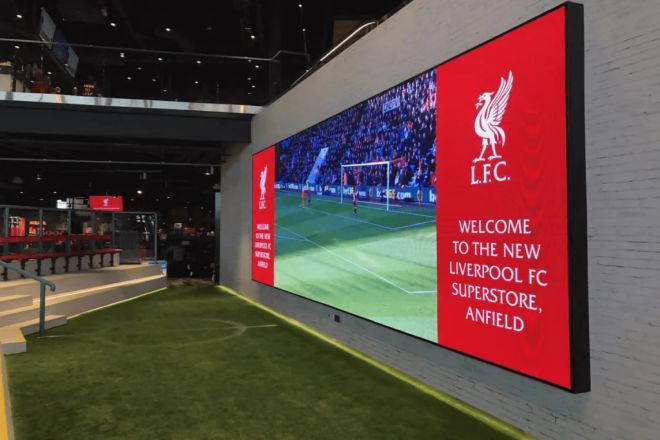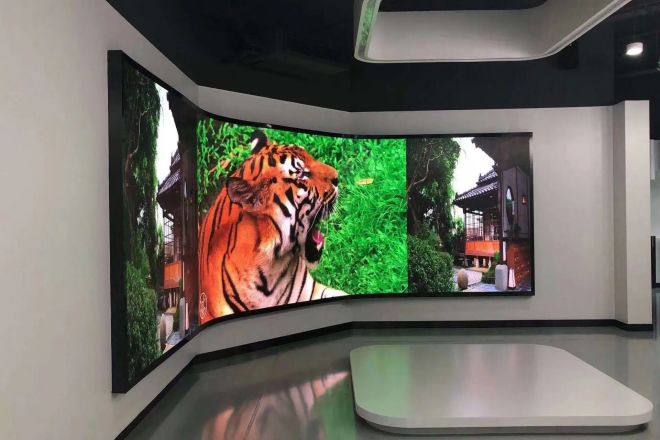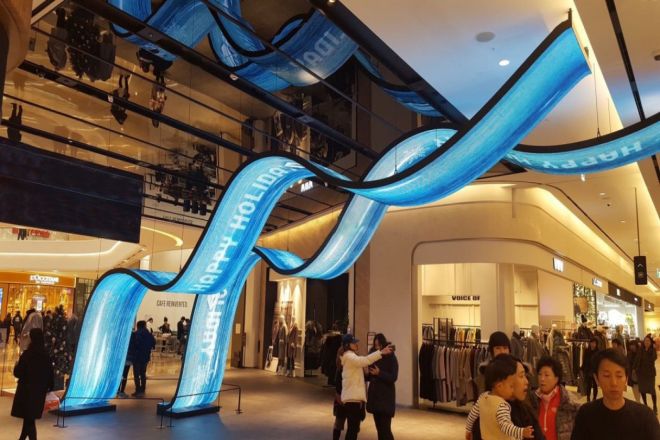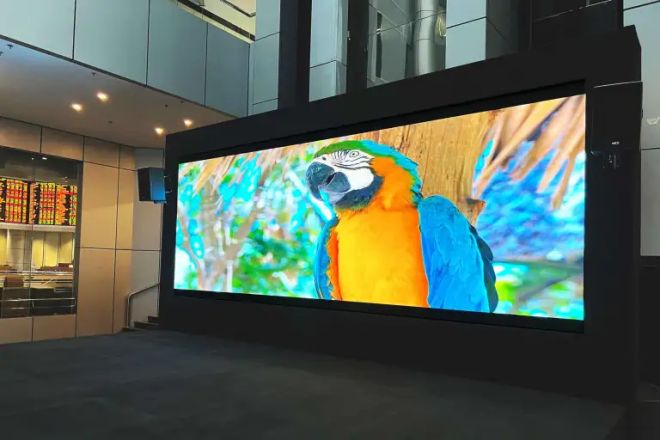Introduction

With the rapid development of science and technology, LED display screens, as an important medium for modern information dissemination, have been widely used in various indoor places.
They not only have the advantages of energy conservation and environmental protection, long life, and high brightness, but they also can display information in a colorful form and become the focus of attracting the attention of the audience.
However, just having an LED display is not enough to ensure its attractiveness. How to reasonably use and optimize the display screen to make it stand out in the indoor environment has become an issue that we need to discuss in depth.
1. What are the key features that make some indoor LED displays stand out from other displays on the market?
- High-definition picture quality and color expression
High-definition picture quality means that the image is very clear, and the color expression means that the screen can accurately and vividly display various colors. Just like we take photos with mobile phones, the higher the pixels, the clearer the photos.
Similarly, the high-definition LED display is like a large high-pixel camera, which can be displayed very clearly in both pictures and videos. Moreover, its color is also very good, and it looks brighter and more realistic.
- Interactive and enhanced experience
Interactivity means that the audience can interact with the display screen through touch, voice, and other means to have a richer experience. Some LED displays are like a large smart tablet. We can touch it with our hands or talk to it, and then it will respond to our movements or sounds.
In this way, the audience can no longer just watch passively but can actively participate in it, making the experience more interesting and in-depth.
- Innovative design is eye-catching
Innovative design refers to a breakthrough in the appearance, shape, or structure of the display screen, which is different from the traditional display screen. Some LED displays are not only a square screen, but they may have various shapes, such as arcs, circles, etc., or have some special decorations and designs. This design makes them look more special and easier to attract people’s attention.
- Energy conservation, environmental protection, and cost reduction
Energy conservation and environmental protection means that the display screen consumes less energy and generates less heat at the same time, which is environmentally friendly and can reduce operating costs.
The energy-saving and environmentally friendly LED display is like a big TV that can save electricity. It does not need to consume too much electricity and does not generate too much heat. In this way, the place where it is used can save electricity and be better for the environment.
- Long life reduces maintenance
Long life means that the display has a long service life, is not prone to failure, and reduces the frequency of maintenance and replacement. Some LED displays are very durable and can be used for a long time without frequent repair or replacement.
For the place where it is used, it means that you can spend less time and money on maintenance.
- Intelligent control and convenient operation
Intelligent control means that the display screen can be controlled through an intelligent system or device, which is convenient for adjusting various parameters and functions.
The intelligently controlled LED display screen can be remotely controlled through mobile phones, computers, and other devices. In this way, we can adjust its brightness, color, and other settings anytime and anywhere, which is very convenient.
- Diversified application scenarios to meet the needs
Diversified application scenarios mean that the display screen can adapt to different use environments and needs, such as commercial advertisements, conference displays, entertainment activities, etc.
Whether it is a billboard in the mall, a large screen in a conference room, or a stage background in a bar, this LED display can be used. They can be adjusted according to different occasions and needs to meet various usage scenarios.
2. The optimal resolution and pixel spacing of the indoor LED display

The optimal resolution and pixel spacing of the indoor LED display are not fixed but depend on multiple factors, including the size of the display, viewing distance, budget, and specific application scenarios.
First of all, the resolution determines the clarity and detailed performance of the display. For indoor LED displays, high resolution means that a more delicate and clearer image can be presented. However, high resolution also means higher costs, so there is a need to trade-off between budget and actual needs.
Usually, the resolution of the indoor LED display should be at least 1920*1080, which is often referred to as 2K resolution, to ensure high-quality visual effects. In some special applications, such as big data display systems or 4K source playback, higher resolution may be required, such as 4K or higher.
Secondly, pixel spacing is also a key factor affecting the visual effect of indoor LED displays. Pixel spacing refers to the distance between the centers of adjacent pixels, usually in millimeters. The smaller the pixel spacing, the more pixels per unit area, and the more delicate the image display.
For indoor LED displays that can be viewed closely, such as shopping malls, conference rooms, etc., small pixel spacing is ideal, such as P2 or P3. These pixel spacing can provide clear images and delicate details.
For example, when we stand very close to the display screen if the pixel spacing is large, there may be an obvious “granular feeling” on the screen, which will affect the viewing experience. Therefore, when choosing an indoor LED display, we should also consider the viewing distance.
If the audience usually looks at the display screen very close to each other, then we should choose products with smaller pixel spacing.
However, it should be noted that the choice of optimal resolution and pixel spacing is not immutable. They should be flexibly adjusted according to specific application scenarios and viewing distances. For example, in large-scale conferences or performances, the audience is far away, and large pixel spacing and moderate resolution can be appropriately selected to balance cost and visual effects.
In addition to resolution and pixel spacing, there are other factors that will also affect the visual effect of the indoor LED display, such as brightness, contrast, color performance, etc.
Therefore, when choosing an indoor LED display, you need to consider multiple factors to find the most suitable product for your needs.
3. The viewing angle of the indoor LED display

The viewing angle of the indoor LED display refers to the maximum or minimum angle at which the human eye can clearly see the display screen, which is a reference value.
Generally speaking, the viewing angle is based on the contrast change as the reference standard. When the observation angle increases, the contrast of the display image seen at this position will decrease, and when the angle increases to a certain extent, and the contrast decreases to 10:1, this angle is the maximum angle of the LED display.
Specifically, the viewing angle of the LED display includes two indicators: horizontal viewing angle and vertical viewing angle. The horizontal viewing angle is based on the vertical normal of the full-color LED display (that is, the vertical imaginary line in the middle of the LED display), and the angle range of the display image can still be seen normally at a certain angle perpendicular to the left or right of the normal.
The vertical viewing angle is subject to the horizontal norma, and the upper and lower viewing angles are called vertical viewing angles.
Generally speaking, the viewing angle of the indoor LED display can reach about 140 degrees, and the vertical can also reach a similar angle. However, this angle is not fixed; it varies according to the screen size and application scenarios.
In some special cases, such as high-definition LED small pitch display, its viewing angle may be larger, such as the maximum horizontal viewing angle and vertical viewing angle reaching 160°.
It should be noted that after exceeding the maximum viewing angle, blind spots or display color distortion may appear in the human eye. Therefore, when choosing an indoor LED display, it is necessary to determine the appropriate viewing angle according to the actual needs and scenes to ensure that the audience can get the best viewing experience.
4. How does the overall design and beauty of the indoor LED display affect the atmosphere and atmosphere of the space or activity?

The overall design and beauty of the indoor LED display play a crucial role in affecting the atmosphere of the space or activity.
A well-designed LED display can not only provide a high-quality visual experience but also coordinate with the surrounding environment to create an atmosphere that meets the needs of a specific space or activity.
First of all, the overall design determines the appearance and style of the display. According to the characteristics of space or activities, you can choose different design styles, such as modern simplicity, scientific and technological sense, artistic sense, etc.
A display design that matches the overall environment can enhance the overall beauty of the space and improve the grade and taste of the activity.
Secondly, the color and brightness adjustment of the display screen are also the key to creating an atmosphere. Through accurate color rendering and brightness control, different emotional atmospheres, such as warmth, romance, and excitement, can be created.
For example, in shopping malls, the use of LED displays to play bright and dynamic advertising pictures can attract the attention of customers and increase the shopping atmosphere, while in hotels or restaurants, soft and comfortable colors, and brightness can create a relaxed and pleasant dining environment.
In addition, the content playback of the display screen is also an important factor affecting the atmosphere. According to the theme and purpose of the activity, different videos, pictures, and text can be played to create a corresponding atmosphere.
For example, in a concert or performance, playing wonderful performance pictures through the LED display screen can enhance the audience’s sense of presence and immersion; in a conference or exhibition, professional presentations or pictures can be displayed to create a professional and formal atmosphere.
Finally, the layout and installation of the display will also affect the atmosphere of the space or activity. Reasonable layout and installation can make the display screen better integrated into the overall environment and avoid a sense of abruptness.
For example, the display screen can be embedded in the wall or hung on the ceiling to integrate it with the surrounding environment; multi-screen splicing technology can also be used to create a more shocking visual effect.
Conclusion
That’s all about this article. If you want to know more about indoor LED displays, please get in touch with us.
